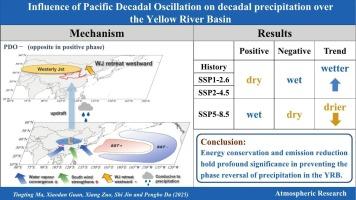太平洋年代际振荡对黄河流域年代际降水变化的影响
IF 4.4
2区 地球科学
Q1 METEOROLOGY & ATMOSPHERIC SCIENCES
引用次数: 0
摘要
1961 - 2022年黄河流域降水呈现出北部偏干、南部偏湿的年代际变化特征。基于集合经验模态分解(EEMD)方法,研究发现太平洋年代际涛动(PDO)是YRB降水年代际变率的关键调节因子。在PDO正相期间,YRB大部分地区降水显著减少,而在PDO负相期间降水增加。进一步的研究表明,这种分布与水汽输送和大气环流密切相关。在PDO正相期间,西风急流的核心(20°N-60°N, 80°E-160°E)位于YRB西北部,在其东南外围形成气旋环流。同时,水汽以辐散为主,水汽条件不足。这种构造抑制了上升运动,抑制了盆地的降水。相反,在PDO负相期间,西风急流向西后退并减弱,导致从海洋到YRB的暖湿空气输送增加。耦合模式比对项目第6阶段(CMIP6)的多模式模拟结果表明,在PDO正、负相期间,YRB降水的年代际趋势呈现相反的模式。在SSP585情景、SSP126情景和SSP245情景下,长江三角洲降水相位相对于历史时段发生逆转,对长江三角洲未来社会经济发展产生深远影响。本研究为研究长江流域年代际降水变率的物理驱动机制提供了新的思路,为未来气候预测和区域水资源管理提供了有价值的参考。本文章由计算机程序翻译,如有差异,请以英文原文为准。

Influence of pacific decadal oscillation on decadal precipitation variation over the Yellow River Basin
Precipitation in the Yellow River Basin (YRB) shows contrasting decadal changes from 1961 to 2022, with the northern part becoming drier and the southern part becoming wetter. Based on ensemble empirical mode decomposition (EEMD) method, this study finds that the Pacific Decadal Oscillation (PDO) is a key moderator of the decadal variability of precipitation across the YRB. Specifically, precipitation decreases significantly over most parts of the YRB during positive PDO phase, while it increases during negative phase. Further studies revealed that this distribution is closely related to water vapor transport and atmospheric circulation. During the positive PDO phase, the core of the westerly jet (20°N-60°N, 80°E-160°E) is located over the northwest of the YRB, generating a cyclonic circulation at its southeastern periphery. Meanwhile, the water vapor is dominated by divergence, resulting in insufficient water vapor conditions. This configuration inhibits upward movement and suppresses precipitation in the basin. In contrast, during the negative phase of the PDO, the westerly jet receded to the west and weakened, resulting in increased transport of warm moist air from the ocean to the YRB. Multi-model simulation results from the Coupled Model Intercomparison Project Phase 6 (CMIP6) show that the decadal trends of precipitation in the YRB show opposite patterns during the positive and negative phases of the PDO. The YRB precipitation phase reverses under the SSP585 scenario with respect to the historical period, the SSP126, and SSP245 scenarios, which has a profound impact on the future socio-economic development of the YRB. This study provides new insights into the physical drivers of decadal precipitation variability over the YRB, offering a valuable reference for improving future climate projections and regional water resource management.
求助全文
通过发布文献求助,成功后即可免费获取论文全文。
去求助
来源期刊

Atmospheric Research
地学-气象与大气科学
CiteScore
9.40
自引率
10.90%
发文量
460
审稿时长
47 days
期刊介绍:
The journal publishes scientific papers (research papers, review articles, letters and notes) dealing with the part of the atmosphere where meteorological events occur. Attention is given to all processes extending from the earth surface to the tropopause, but special emphasis continues to be devoted to the physics of clouds, mesoscale meteorology and air pollution, i.e. atmospheric aerosols; microphysical processes; cloud dynamics and thermodynamics; numerical simulation, climatology, climate change and weather modification.
 求助内容:
求助内容: 应助结果提醒方式:
应助结果提醒方式:


